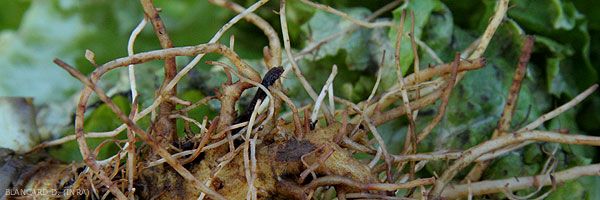
Ammonia toxicity
(Large non-parasitic pivot)
The primary symptoms of ammoniacal toxicity are manifested in the vascular system of salads and in particular in the taproot of the main root. The latter takes a yellow tint evolving towards light brown, then dark to reddish. Contiguous tissues may be affected and show browning, reddening and cavities (Figure 1). (Do not confuse these symptoms with those caused by fusarium wilt / Fusarium oxysporum f. Sp. Lactucae )
The lateral roots are shorter, the cortex yellows, browns, gradually corks before showing longitudinal sleeves and fissures, giving rise to suspicion of an attack of corky root disease caused by Pyrenochaeta lycopersici (figures 2 and 3). Note that the root lesions are generalized or localized to the area of the root system corresponding to the location of the fertilizer.
Plant growth is reduced (Figures 4 and 5). We also note their temporal wilting, their dark green tint, and the presence on the lamina of peripheral yellowing V-shaped becoming necrotic (Figures 6 and 7).
This intoxication seems particularly damaging on young salad plants, and in particular in fresh soils, with a surface crust or compacted, situations which induce slow nitrification. It is the same in poorly drained plots, and soils saturated with water. The use of fertilizers with a high ammonium content or activator of decomposition of organic matter contributes to this toxicity.





